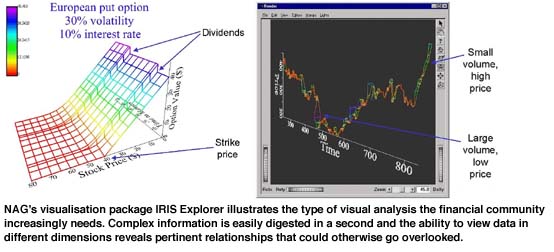Numerical Algorithms Group
by David Sayers
Numerical Algorithms Group Ltd (NAGTM), a not-for-profit software
house, is the UK’s leading producer and supplier of mathematical
computer software for business, education and industry. A key
focus and growth area is the complex world of finance. Here, according
to NAG technical consultant David Sayers, the role that his company’s
technology could play in delivering competitive advantage is tantalisingly
ripe for discovery.
NAG was founded in an academic research environment. It was created
in 1970 by numerical analysts co-ordinated from the University
of Nottingham, moved to Oxford in 1973, then expanded to become
an international group. Today NAG continues to be driven by a
network of research professionals from around the world. Its successes
to date have always depended on integrating this world effectively
with that of the ‘real’ world as experienced by the end users
of its technology. Nag is committed to secure future successes
by adopting the same approach. For example, there is little point
forging ahead with research to heighten accuracy, when customers
have a more pressing need for speed of delivery. NAG has recently
launched a proactive initiative to investigate the financial customer
base in more detail, to direct its research network to deal more
closely with the real life problems financial analysts have to
solve today....and tomorrow.
NAG’s numerical libraries are already used extensively in financial
institutions around the world, here NAG is prized for the high
quality, reliability and speed of its software, scope (in terms
of the range of solutions available) and attentive level of technical
support. The customer base is wide ranging, some users work on
the smallest PC while others manage the most modern supercomputers;
they use a variety of computing languages. A key requirement these
institutions have in common is the need to use NAG routines to
develop unique in-house trading and pricing strategies, something
that is not possible with off-the-shelf complete packages.
For those with particularly complex financial challenges, NAG
also offers a consultancy service. Recent work, for example, involved
a sophisticated portfolio tracking program and the provision of
a bespoke module for trading in global currency and bond markets.
The same NAG mathematical consultants are constantly considering
general trends in the marketplace to direct software development.
Key trends already identified include interest in the single European
currency. NAG has already predicted a refinement in investment
strategies based on a much larger global portfolio of shares than
at present in Europe. The indices will now cross the European
spectrum of shares not just those quoted on the local exchanges.
Problem sizes will be larger, leading to a greater demand for
more powerful routines capable of solving larger problems. Here
NAG’s multi-processor libraries (SMP and Parallel libraries) are
the ideal solution.
Another interesting development under scrutiny is the inclusion
of transaction costs in portfolio modelling. This leads to the
minimisation of numerically difficult discontinuous functions.
Accordingly, major software systems will need to rely on NAG’s
expertise and quality to solve complex problems.
Derivatives are also becoming more complex – with simple option
pricing giving way to the more complicated problem of pricing
exotic derivatives. Black-Scholes models are now starting to give
way to more sophisticated models.

As European markets change, so will the regulatory bodies and
surrounding legislation. Dealers will need to know how their books
stand at the end of the day, to meet both the regulatory requirements
and the ‘risk of exposure’ requirements of their own managers.
With NAG’s flexible solvers, the adaptation to changing circumstances
is made possible. NAG is also already anticipating new breeds
of programmers graduating from universities. These people are
moving away from the traditional library approach to problem solving.
They will need either more sophisticated components or solution
modules that interface to ‘packages’ or ‘problem solving environments’.
Users will have ever increasing amounts of data to analyse and
assess. This will require good visualisation capabilities and
a system capable of performing meaningful and powerful statistical
analysis of that data.
Looking ahead, NAG is committed to meeting financial analysts’
need for speedier, accurate solutions by enhancing the numerical
libraries that have already gained a considerable following in
this community. The company will also deliver the security and
flexibility these customers require. As architectures change,
so the libraries will change to fully exploit new features and
to embrace the increasing need for thread-safety. At the same
time, NAG will enhance the libraries with newer and more powerful
solvers, keeping pace with the rapid advances in numerical techniques.
In addition, further work will focus on presenting NAG’s numerical
techniques in new ways, ensuring the power of this technology
can be accessed by news types of user.
NAG also anticipates a surge in awareness of the competitive advantage
of using visualisation packages, again a key area for the new
types of user. NAG’s own package, IRIS Explorer(tm) can be combined
with the reliable engines of the company’s libraries to form a
bespoke computational and visualisation program. This is a vital
development in the financial world where, for example, dealers
are under pressure to absorb the results of a calculation at a
glance. Numbers are not sufficient. NAG is set to develop more
visualisation modules to meet the expected demand for increasingly
more powerful tools in this area.
Further focus areas and challenges will doubtless emerge. NAG
anticipates with relish that the rate of change and pace of software
development will be phenomenal. For more information on NAG, see
http://www.nag.co.uk.
Please contact:
David Sayers - NAG Ltd
Tel: +44 186 551 1245
E-mail: david@denham.nag.co.uk
